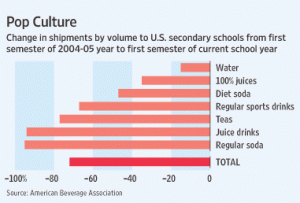Jamie Oliver’s food revolution. Yes!
I’m not much of a TV-watcher but from what I’ve been hearing about Jamie Oliver’s new series, I thought I had best take a look.
Don’t miss it. Get your kids to watch it with you.
Oliver, in case you haven’t been paying attention, went to Huntington, West Virginia (ostensibly the obesity capital of the world), TV crew in hand, to reform the town’s school lunch program.
Take a deep breath. Try not to get turned off by Oliver’s statement that “the food revolution starts here” (no Jamie, it doesn’t). Try not to cringe when he calls the food service workers “girls” and “luv” (OK, it’s a cultural problem). Remember: this is reality TV.
With that said, let’s give the guy plenty of credit for what he is trying to do: cook real food. What a concept!
And let’s cut him some slack for what he is up against: USDA rules that make cooking too expensive for school budgets, entrenched negative attitudes, widespread cluelessness about dietary principles as well as what food is and how to cook it, and kids who think it is entirely normal to eat pizza for breakfast and chicken nuggets for lunch, neither with a knife and fork.
What impressed me most is that Oliver is going about addressing these barriers in exactly the right way. From my observations of school food over the years, the key elements for getting decent food into schools are these:
- A principal who cares about what kids eat
- Teachers who care about what kids eat
- Parents who care about what kids eat
- Food service personnel who not only care what the kids eat, but also know the kids’ names.
For a school food program to work, all of these elements must be in place. That’s why the school food revolution must be achieved one school at a time.
Watch Oliver go to work on these elements in this one school.
Teacher that I am, for me the most moving – and hopeful – sign was what happened in the classroom. Oliver holds up tomatoes and asks the kids what they are. No response. Not one kid recognizes a potato or knows it as the source of French fries.
How does the teacher react? As any great teacher, she recognizes a teachable moment and uses it. When Oliver returns to that class, the kids recognize and can name vegetables, even an eggplant.
This program has much to teach us about the reality of school food and what it takes to fix it. That is why I so appreciate the comments of the New York Times reviewer. His review ended with this comment:
One thing noticeably absent from the first two episodes is a discussion of any role the American food industry and its lobbyists might play in the makeup of school lunches and in the formulation of the guidelines set for them by the Agriculture Department. If Mr. Oliver wants a real food revolution, it can’t happen just in Huntington.
Yes!
Addendum #1: Here’s Jamie Oliver’s TED talk.
Addendum #2: the case against Jamie Oliver, courtesy of reason.com (unreason?).



